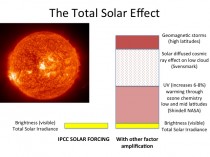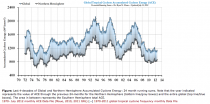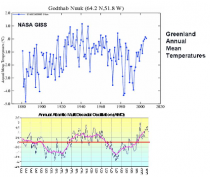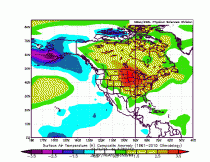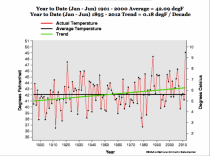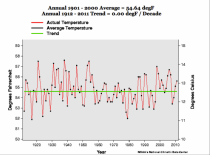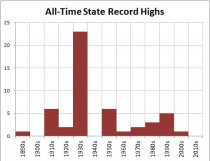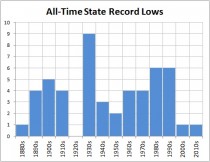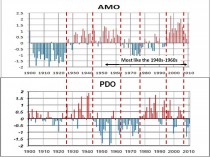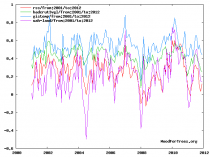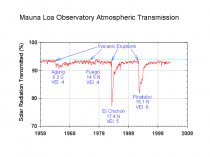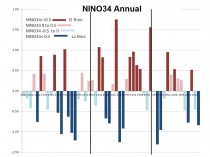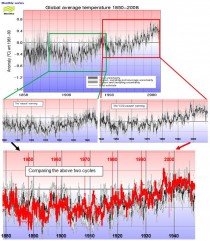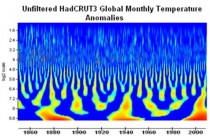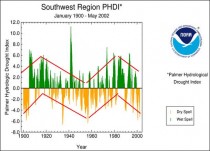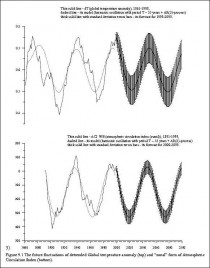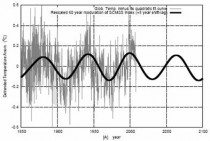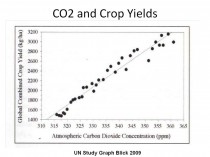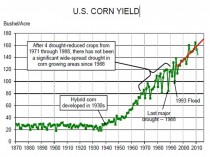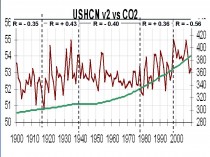Dr Ryan Maue, Weatherbell.com
See Ryan’s model pge on weathrbell.com.
Hurricane expert Dr. Ryan Maue pulls no punches when it comes to putting John Abraham of the Climate Science Rapid Response Team in his place:
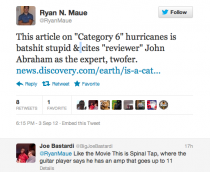 Here’s what Abraham has to say at Discovery News:
Here’s what Abraham has to say at Discovery News:
But wind speeds don’t tell the whole story, said John Abraham, a thermal scientist at the University of St. Thomas in St. Paul, Minn. The size of a storm, the amount of rain it dumps, and the size of the wave surges it produces also determine how damaging a hurricane will be, even though the category scale doesn’t take those details into account.
“The hurricanes that really matter, that cause damage, are increasing,” Abraham said. “What scientists have been saying would happen for decades is now happening. There’s an economic cost to not doing anything about this problem.”
Umm, no, when you look at the frequency and accumulated energy in hurricanes at Dr. Ryan Maue’s Tropical web page, you find it trending down:
Historical Tropical Cyclone Activity Graphics
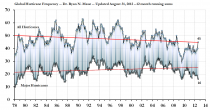
Figure: Global Hurricane Frequency (all & major) - 12-month running sums. The top time series is the number of global tropical cyclones that reached at least hurricane-force (maximum lifetime wind speed exceeds 64-knots). The bottom time series is the number of global tropical cyclones that reached major hurricane strength (96-knots+). Adapted from Maue (2011) GRL.
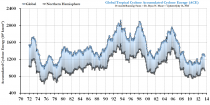
Figure: Last 4-decades of Global and Northern Hemisphere Accumulated Cyclone Energy: 24 month running sums. Note that the year indicated represents the value of ACE through the previous 24-months for the Northern Hemisphere (bottom line/gray boxes) and the entire global (top line/blue boxes). The area in between represents the Southern Hemisphere total ACE. 1970- July 2012 monthly ACE Data File (Maue, 2010, 2011 GRL) [--] 1970-2011 global tropical cyclone frequency monthly Data File
Dr. Patrick Michaels points out last Friday in this excellent essay on hurricanes:
It’s been 2,535 days since the last Category 3 storm, Wilma in 2005, hit the beach. That’s the longest period - by far - in the record that goes back to 1900.
Quite a drought. He adds:
Aren’t there more whoppers - the powerful Category 4 and 5 monsters that will mow down pretty much anything in their path? As is the case with much severe weather, we simply see more than we did prior to satellites and (in the case of hurricanes) long-range aircraft reconnaissance. As the National Hurricane Center’s Chris Landsea (with whom I have published on tropical cyclones) has shown, if you assume the technology before satellites, the number of big storms that would be detected now is simply unchanged from the past.
There’s a pretty good example of this spinning in the remote Atlantic right now, which is Hurricane Kirk, far away from shipping channels, land, and nosy airplanes. Kirk is compact enough that it would likely have been completely missed fifty years ago. If it spins up into a Category 4 (which is currently not forecast), that would be another biggie that would have gotten away, back in the day.
There’s another reason that the increase in frequency is more apparent than real: “shorties”. That’s what Landsea calls the ephemeral tropical whirls of little consequence that are now named as storms more because of our detection technology than anything else. There’s also probably an overlay of institutional risk aversion in play, as it is now recognized that seemingly harmless thunderstorm clusters over the ocean can spawn decent floods when they hit land.
There is another driver for an increase in Atlantic hurricane frequency that isn’t operating elsewhere. In 1995, a sudden shift in the distribution of North Atlantic temperatures increased hurricane frequency. Landsea predicted - at the time - that the Atlantic would soon fire up from its hurricane doldrums of the previous two decades, which it did. This type of shift has occurred repeatedly in the last century, both before and during (modest) global warming from greenhouse gases.
The influence of technology on storm reporting is something I’ve talked about in great detail before:
Why it seems that severe weather is “getting worse” when the data shows otherwise – a historical perspective
Abraham is clueless. Freelance writer Emily Sohn, judging by some of her other articles, might well fit into the label Maue applies to the hurricane story.
-----------------------------------
Wacko Enviro professor says snow will vanish from Australia by 2020
ENVIRONMENTAL researchers say the end of Australia’s ski culture is in sight, despite Victoria and NSW experiencing one of their best snow seasons in almost a decade.
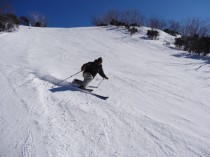
People were still shredding up powder last weekend at some of Australia’s top ski resorts, but Griffith associate professor Catherine Pickering says snow is rapidly disappearing because of global warming and by 2020 Australia may not have any left.
“We’ve predicted by 2020 to lose something like 60 per cent of the snow cover of the Australian Alps,” Professor Pickering, from the Griffith School of Environment, said.
“Unfortunately because our current emissions and our current rises in temperatures are at the high end of the predictions, it’s definitely coming to us sooner and faster.”
Professor Pickering researched the effects of declining snow cover and hotter summers on the Australian Alps and says this year’s better than average season has been a one-off combination of La Nina and a cold snap.
“We’ll still occasionally have good years, but they’ll become less frequent,” she said. “A poor year in the past will be a good year now.”
The research covered all Victoria and NSW ski resorts and Professor Pickering says the alpine region is most threatened by climate change, with an increasing threat to endemic and endangered mountain species as well as plants because of early thaws.
Ski resorts will have to rely heavily on snow machines, she said, which was not sustainable.
“Ski resorts will have to increase snow making ...which is limiting in cost and water,” she said. “Because we don’t have very high mountains . . . we don’t have large water catchments above our resorts. In a few years, the amount of water that ski resorts will need to make snow is going to exceed the amount of water that’s used by Canberra.”
Professor Pickering said because of rising costs and diminishing snow coverage, Australian skiers would go overseas to Europe or the US.
Italian ski instructor Rene Crazzolara, who spends seven months a year at Thredbo, NSW, says Australia’s poor seasons are not to do with global warming, but our low altitude when compared with European terrain: “Europe has generally better skiing because it has higher mountains. It’s not global warming, it’s altitude.”
---------
Rene is exactly right. Australian snow is more variable because the terrain is not like the Alps. However, Pickering is going to be dead wrong because we have entered the cold PDO mode likely to last another 15 -20 years. The cold PDO favors more La Ninas and cold, snowy winters. It is the same mistake the alarmists made in the northern hemisphere a decade ago promising snow would be a rare commodity endangering the winter sports industry. 4 of the top 5 snowiest years on record have occurred in the last decade.
by: Peter Lilley, The Australian
BRITAIN embarked on a hugely ambitious policy to decarbonise its economy with virtually no scrutiny of the costs. Now those costs are starting to hit families and firms.
When challenged, the government bases its claim that the benefits to the world exceed the costs to British taxpayers on the Stern review on The Economics of Climate Change—on which Australia’s Garnaut review was modelled.
Yet the Stern review has now been shown to be fundamentally flawed—leaving all three parties that have defended this policy with a huge dilemma.
Their defence of climate change policy rests on two pillars—scientific and economic.
The UN Intergovernmental Panel on Climate Change “settled the science”. It is a slightly shaky pillar since the Council of National Science Academies criticised the IPCC “for emphasizing the negative impacts of climate change, reporting high confidence in some statements for which there is little evidence”.
Nonetheless, the science has a solid basis. Having studied physics at Cambridge, I accept that without greenhouse gases this planet would be a frozen barren rock. The direct effect of doubling the concentration of carbon dioxide will be to raise the global temperature by 1C—amplified by feedbacks about whose size and even direction there is more uncertainty.
I take the IPCC assessment of the science as given so as to focus on my main concern, which has always been about the equally crucial economic questions: how much is it worth, and how much will it cost, to restrict carbon dioxide emissions and temperature increases?
The economic pillar was always far flimsier since it relied on Stern—a government economist, commissioned by the government, who produced the answer the government needed. Moreover, Stern’s key conclusion—that the benefits of reducing emissions would be five to 20 times the cost—flatly contradicts the IPCC, which concluded: “costs and benefits are broadly comparable in magnitude” so it could not establish “an emissions pathway or stabilisation level where benefits exceed costs”. Most environmental economists whose work Stern supposedly reviewed reached conclusions closer to the IPCC.
Nonetheless, Labour ministers and their Conservative/Lib Dem successors cling with increasing desperation to Stern: albeit like the proverbial drunk—more for support than illumination.
To provide that illumination I have undertaken a detailed study—What is Wrong with Stern? The Failings of the Stern Review—published today by the Global Warming Policy Foundation.
Stern reaches conclusions far removed from those of most environmental economists by combining statistical sophistry and verbal virtuosity. For example:
- Comparing a part with the whole. Stern compares the benefit of preventing global warming entirely with the cost of avoiding part of potential global warming by preventing carbon emissions exceeding twice their pre-industrial level.
- Describing future centuries as “now”. Stern claims global warming will cut GDP by least 5 per cent “now and forever”. Yet even on his worst projection, the cumulative losses from global warming over this century are below the costs of mitigation.
- Inconsistent discounting of costs and benefits. Stern discounts benefits of curbing emissions at an ultra-low rate (not revealed in his 700-page report). But he effectively uses the normal market rate to discount the cost of decarbonising the economy—the return forgone on alternative investments. So his estimated cost of avoiding climate change is understated relative to the benefits by between 2 1/2 and five times.
- Strange ethics. Stern condemns those who reject his low discount rate as “unethical” and “lacking concern for future generations” as if global warming threatens humanity with extinction or immiseration. Such a fate is an implausible consequence of a few degrees of warming, costly though that could be, given that mankind flourishes in latitudes whose average temperatures differ by 20C and seasonal extremes vary by 80C. Even in Stern’s worst case, people in 2200 will be seven times richer than today if we do nothing to curb emissions. Why should our generation, not least developing countries (the main source of emissions growth), make sacrifices to make future generations richer still?
- Cherry-picking unreliable studies. A World Bank study shows that Stern’s forecasts of storm damage to infrastructure, based on non-peer-reviewed and alarmist literature, are up to 100 times too large.
- Ignoring adaptation. He cites a study showing a 4C rise could cut yields of one crop variety by 70 per cent but assumes farmers will not switch to another variety whose yields would actually increase—a fact he withholds.
In short, Stern selected and manipulated evidence to back a policy—creating policy-based evidence when what we need is evidence-based policy.
Government economists privately recognise that Stern’s economics are no longer defensible. They fall back on Harvard economist Martin Weitzman’s suggestion that “Stern may be right for the wrong reasons”. Weitzman says: if there is a finite possibility, however small, of an infinitely bad outcome (human extinction) then virtually any cost is justified to prevent it. Paradoxically, using this thesis to rescue Stern’s conclusions means abandoning their scientific pillar—the IPCC’s claim (shared by Stern) that “the science is certain” and climate sensitivity can be derived from known “laws of physics and chemistry”. Instead, Weitzman assumes that neither scientific laws nor empirical studies can set any upper limit on the size of the greenhouse effect.
However, if climate sensitivity is as high as Weitzman’s theory requires to put mankind’s survival at risk, its impact must have been largely concealed by natural variations even before the pause in warming this century. So it should soon become obvious as those fluctuations revert to the mean, giving plenty of time to respond.
There may be a case for a modest, gradual approach to climate change rather than Stern’s crash program. But ministers can no longer rely on the discredited Stern review to defend an unaffordable policy.
Peter Lilley is a British Conservative Party MP
Climate Models That Predict More Droughts Win Further Scientific Support
By Hristio Boytchev, Published: August 13The Washington Post
The United States will suffer a series of severe droughts in the next two decades, according to a new study published in the journal Nature Climate Change. Moreover, global warming will play an increasingly important role in their abundance and severity, claims Aiguo Dai, the study’s author and newly appointed Associate Professor at the University at Albany, Department of Atmospheric and Environmental Sciences beginning September 1st.
His findings bolster conclusions from climate models used by researchers around the globe that have predicted severe and widespread droughts in coming decades over many land areas. Those models had been questioned because they did not fully reflect actual drought patterns when they were applied to conditions in the past. However, using a statistical method with data about sea surface temperatures, Dai, a climate researcher at the federally funded National Center for Atmospheric Research, found that the model accurately portrayed historic climate events.
“We can now be more confident that the models are correct,” Dai said, “but unfortunately, their predictions are dire.”
In the United States, the main culprit currently is a cold cycle in the surface temperature of the eastern Pacific Ocean. It decreases precipitation, especially over the western part of the country. “We had a similar situation in the Dust Bowl era of the 1930s,” said Dai, who works at the research center’s headquarters in Boulder, Colo.
While current models cannot predict the severity of a drought in a given year, they can assess its probability. “Considering the current trend, I was not surprised by the 2012 drought,” Dai said.
The Pacific cycle is expected to last for the next one or two decades, bringing more aridity. On top of that comes climate change. “Global warming has a subtle effect on drought at the moment,” Dai said, “but by the end of the cold cycle, global warming might take over and continue to cause dryness.”
While the variations in sea temperatures primarily influence precipitation, global warming is expected to bring droughts by increasing evaporation over land. Additionally, Dai predicts more dryness in South America, Southern Europe and Africa.
“The similarity between the observed droughts and the projections from climate models here is striking,” said Peter Cox, a professor of climate system dynamics at Britain’s University of Exeter, who was not involved in Dai’s research. He said he also agrees that the latest models suggest increasing drought to be consistent with man-made climate change.
ICECAP NOTE: The AGW role is nonsense. and he only has it half right (the Atlantic AMO is also important - probably more so).
By Roger Pielke Sr., Climate Science
The American Meteorological Society has released its Statement
Climate Change - An Information Statement of the American Meteorological Society
where its stated intent starts with
The following is an AMS Information Statement intended to provide a trustworthy, objective, and scientifically up-to-date explanation of scientific issues of concern to the public at large.
Unfortunately, the Statement then goes on to write [highlight added]
It is clear from extensive scientific evidence that the dominant cause of the rapid change in climate of the past half century is human-induced increases in the amount of atmospheric greenhouse gases, including carbon dioxide (CO2), chlorofluorocarbons, methane, and nitrous oxide. The most important of these over the long term is CO2, whose concentration in the atmosphere is rising principally as a result of fossil-fuel combustion and deforestation.
The new AMS Statement on Climate Change focus on primarily CO2 has already been refuted as documented in the National Research Council Report
National Research Council, 2005: Radiative forcing of climate change: Expanding the concept and addressing uncertainties. Committee on Radiative Forcing Effects on Climate Change, Climate Research Committee, Board on Atmospheric Sciences and Climate, Division on Earth and Life Studies, The National Academies Press, Washington, D.C., 208 pp.
and summarized in the American Geophysical Union EOS article
Pielke Sr., R., K. Beven, G. Brasseur, J. Calvert, M. Chahine, R. Dickerson, D. Entekhabi, E. Foufoula-Georgiou, H. Gupta, V. Gupta, W. Krajewski, E. Philip Krider, W. K.M. Lau, J. McDonnell, W. Rossow, J. Schaake, J. Smith, S. Sorooshian, and E. Wood, 2009: Climate change: The need to consider human forcings besides greenhouse gases. Eos, Vol. 90, No. 45, 10 November 2009, 413. Copyright (2009) American Geophysical Union.
where specific evidence was presented that clearly shows that the assumption of the dominance of increased atmospheric concentration of CO2 on altering climate is wrong. In the EOS article we documented that the only non-rejected hypothesis (of the three listed) is
Although the natural causes of climate variations and changes are undoubtedly important, the human influences are significant and involve a diverse range of first-order climate forcings, including, but not limited to, the human input of carbon dioxide (CO2). Most, if not all, of these human influences on regional and global climate will continue to be of concern during the coming decades.
We wrote in the article that
In addition to greenhouse gas emissions, other first-order human climate forcings are important to understanding the future behavior of Earth’s climate. These forcings are spatially heterogeneous and include the effect of aerosols on clouds and associated precipitation [e.g., Rosenfeld et al., 2008], the influence of aerosol deposition (e.g., black carbon (soot) [Flanner et al. 2007] and reactive nitrogen [Galloway et al., 2004]), and the role of changes in land use/land cover [e.g., Takata et al., 2009]. Among their effects is their role in altering atmospheric and ocean circulation features away from what they would be in the natural climate system [NRC, 2005]. As with CO2, the lengths of time that they affect the climate are estimated to be on multidecadal time scales and longer.
The American Meteorological Society itself has a 2010 Statement that contradictions their new Statement on Climate Change. That Statement is titled
Inadvertent Weather Modification - An Information Statement of the American Meteorological Society
Inadvertent weather modification is defined in the Statement as
Inadvertent weather modification is the unintended consequence of an act, either on purpose or accidentally, that results in changes in the weather.
Inadvertant weather modification is clearly part of “climate change”.
The Statement on Inadvertent Weather Modification starts with the text
This statement highlights the causes and possible effects of inadvertent weather modification1 at local and regional scales due to aerosol2 and gas emissions3 and to changes in land use. The known effects can have unanticipated and often undesirable socioeconomic consequences. This statement assesses the impacts of inadvertent weather modification and suggests potential respective actions.
and concludes with
These research efforts on unintended weather modification should be recognized as addressing parts of the broader question of climate variability and change, which crosses geopolitical boundaries. As was the case with acid rain and stratospheric ozone depletion, national and international frameworks should be developed for addressing the related environmental and ethical issues for inadvertent weather modification.
It is clear that in the new AMS Statement on Climate Change they decided to ignore the Inadvertent Weather Modification Statement by the same society! We were precluded from not headlining the Inadvertent Weather Modification Statement as being on climate, but the last paragraph clearly shows it is very much relevant (and broadens quite significantly) what should in the AMS Statement. I am a Fellow of the AMS, and I am very disappointed that the writers of the Statement on Climate Change did not have the courtesy, nor the perspective, to include what was reported in AMS Statement on Inadvertant Weather Modification.
As a final note on the AMS Statement on Climate Change, they also write
climate models have demonstrated skill in reproducing past climates.
Readers of my weblog should know this is an erroneous claim as documented in the peer-reviewed papers that have been summarized most recently in the post
CMIP5 Climate Model Runs - A Scientifically Flawed Approach
I summarize in the post the requirements to make a claim such as “climate models have demonstrated skill in reproducing past climates”, with the text
The first requirement of the CMIP5 runs, before they should even be spending time and money on projections, is that they must skillfully (and shown with quantitative analyses) to replicate the statistics of the current climate, and replicate the changes in climate statistics over this time period. However, peer-reviewed studies that have quantitatively examined this issue using hindcast runs show large problems even with respect to current model statistics, much less their change over time.
I concluded that post with the text with respect to the evidence from the peer-reviewed papers that
These studies, and I am certain more will follow, show that the multi-decadal climate models are not even skillfully simulating current climate statistics, as are needed by the impacts communities, much less CHANGES in climate statistics. At some point, this waste of money to make regional climate predictions decades from now is going to be widely recognized.
It is clear that the new AMS Statement Climate Change is more advocacy by the leadership of the Society, than a balanced presentation of this subject. When evidence contradicts their advocacy role, they conveniently just ignore it.
Judy Curry also has an excellent post titled
AMS Statement on Climate Change
in which I agree with her conclusion where she wrote
“My strong objections to this type of statement by professional societies has been voiced previously. This statement is worse than the previous AMS statements....In other words, consensus statements get parroted without any actual intellectual examination. In this case, what is the point of the AMS statement. Apparently, to ‘inform the public’ on this controversial issue by appealing to the ‘authority’ of the society.
These Statements (including the one I participated on) are not voted on by the members of the society, nor are the committee members’ names made public. This, along with the absence of an open on-line debate, make this process a sad commentary on a professional society (the American Meteorological Society) which has otherwise done so much for science.
By Tom a. Nelson, Nelson Blogspot
Fraudster Michael Mann: “it’s part of a trend, Katrina, the record season of 2005 was part of a trend towards more destructive storms”
On the Green Front - Dr. Joseph Romm and Dr. Michael Mann - 08/15/12 at On the Green Front
Mann at the 40:40 mark: “One of the more robust predictions is that in the Atlantic, hurricane intensities have increased and they will likely continue to increase, and so, it’s part of a trend, Katrina, the record season of 2005 was part of a trend towards more destructive storms..”
Accumulated Cyclone Energy Index (Maue) shows the activity is actually at the lowest level in over 32 years. Don’t expect these climate politically driven, ‘self proclaimed experts’ to ever get it right.
See also this detailed PJM post on Michael Mann - The ghost of climate past here.
--------------------
German National Weather Service: “No Significant Trend To More Drought In Europe...Dryness La Nina -Related”
By P Gosselin on 17. August 2012
In layman’s terms, that means: Forget the man-made global warming poppycock!
There’s been a lot of bed-wetting going on about “increasing” extreme weather events like droughts, floods, heat, tornadoes and dry periods.
All because of climate change? Not so, says the German Weather Service DWD (surprisingly)!
Precipitation over much of Europe over 2011 was 80% or less than normal levels.
The DWD posted 2 days ago an unusually level-headed, sober expert report on what’s behind the dry period that Europe has been experiencing over the last 2 year and half.
Their findings are a real cold water deluge on all the alarmist claims we’ve been hearing in the media over the last weeks.
The DWD’s conclusion: “There’s no long-term significant trend. The suspect is a two-year La Nima impact in connection with a positive North Atlantic Oscillation”. Hat-tip: Meteorologist K.E. Puls.
What follows is a translation of their German summary (my emphasis):
Summary
The dry period of winter 2011/12 and spring 2012 was as a whole not so strongly pronounced like in the spring and autumn of a year earlier (for the previous year, see Trachte et al. 2012), but it can be ranked as local and extreme. Wide areas of Europe were impacted, and to different extents and at different time periods. Over the Iberian Peninsula, this period of drought began in December 2011 and then spread to Western, Central and Southern Europe by March. Heavy precipitation in Western Europe then ended the period of low precipitation. However, ground moisture in April and May remained generally very low, thus causing the hydrological drought to extend over the entire spring of 2012. Over the long-term, since the beginning of the 20th century, there is no significant general trend to more dryness in Europe. However, there are indications that in certain smaller regions dryness and periods of strong precipitation have tended to become more extreme over the last 35 years, foremost the Iberian Peninsula during the winter.
The main meteorological cause of the drought, as is the case for last spring and in fall 2011, is the widespread and stronger high pressure influence in these regions. After examining the corresponding data and some new investigations of the literature, there’s a strong suspicion that a two-year long La Nina (i.e. two La Nina-events in row) were the main cause in all these cases - in connection with a positive North Atlantic Oscillation.”
The text speaks for itself. We are dealing with natural causes. Moreover the authors add:
Record drought for 2012 hardly took place. For example in Uccle (Belgium), where the data-sets begin in the 19th century, even during the dry March-2012 the monthly precipitation amount and the number of days of precipitation was considerably higher than the record low of 1993. In Germany, the spring of 2012 was the 6th driest since the beginning of the 20th century.”
The DWD presents other long-term (non)trends:
Data-sets from region’s middle for individual seasons (See Fig. 9 for winter and spring) do not show any clear trend for any region. Instead we see more ‘or less pronounced year-to-year variability.”
Good to see there are a few meteorologists left at the German National Weather Service who are still sober and have not yet become all drugged up with the global warming cult religion. I wonder if they’ll be allowed to issue reports in the future.
By Joseph D’Aleo
See the compelling interview by David Kreutzer on Fox Business yesterday.
Obama announced yesterday he want to double down on the wind and solar energy initiative and criticized Romney for challenging that. Wind now provides 2.3% of the nation’s electricity needs but only because it was driven by the $100billion in subsidies much of which went to cronies of Obama (a blatant example of crony capitalism). Wind has been around since the ‘80s (1880’s) and solar the ‘90s (1890’s). They were going to be the future in the 1970s but 40 years later they can’t compete with fossil fuels because of the cost.
Also wind is an unreliable energy source like its brother solar. The wind doesn’t always blow, the sun doesn’t always shine. As a result where they have invested heavily in wind they have had to keep fossil fuel and other energy sources in inefficient ready back up to keep the power on. This has failed in Texas where they rely on energy from West Texas a few winters back when arctic air descended on the state, but winds diminished under high pressure in the west where the wind turbines were but kept blowing where the people were in the east, the lights went out. In December, 2010, the second coldest December in the UK since the Little Ice Age in 1659, wind power delivered just 0.6% of the energy needs as the cold arctic air was with calm winds much of the time.
Instead of a job creator, as part of the 4 million green energy jobs promised by Obama in 2008, that has been a dismal failure, creating a claimed 75,000 jobs according to AWEA (a number challenged here). In Spain, the original model for Obama and the greens, they invested heavily in wind and solar but prices rose so high, it drove industry to China and India. 2.2 jobs were lost for every 1 green job created and only 1 in 10 green jobs were permanent. In Italy, it was 3.4 real jobs lost for every green job created. In Spain, unemployment rose to 25.5%, highest of any country. Not a single fossil fuel power plant was shut down and CO2 emissions went up 50% not down. Spain bacause like Don Qiuixote went chasing wind mills, is technically bankrupt in part because of subsidies to renewable energies, which have increased the country’s sovereign debt by some 30 billion dollars to date, plus 8 billion more each year because the subsidies are guaranteed for 20 years. They produce the same amount of electricity as before, but it costs much more. Their 18,000 wind turbines haven’t even reduced the consumption of fossil fuels, because of problems caused by their intermittency have stopped the subsidies and had to be bailed out by Germany. Germany is another country which has seen the light and cut back on the subsidies and are busy building coal plants. They found wind and solar were inefficient and were at the mercy of the Russians for natural gas. In England, Chris Huhne, the disgraced energy secretary now departed had an energy plans that was causing energy prices to skyrocket 140% in just eight years . Fully a quarter of the homes in Wales and most pensioners were in energy poverty, having to choose between heating and eating. When the brutal winters of recent years hit, thousands died from illnesses related to cold exposure. You see higher energy costs is a very regressive ‘tax’ (because it is driven by government policy and bad science) affecting poor and middle class the most. Even where we able to keep the power on (and there would be many brownouts and blackouts - ok by enviro standards as they begrudge our use of energy for HD TV, AC and other conveniences), some people will have to dine by candlelight because they can’t afford to pay the electric bills.
WIND HAS PROVEN TO BE DEADLY
The Audobon Society had challenged its environmental brothers on wind, finding the wind turbines kills hundreds of thousands of birds, including ‘protected’ species like raptors and eagles. Ironically environmental groups went after Exxon and won $600,000 in penalties when 6 birds were found drowned in an oil tank but look the other way at the hundreds of thousands of dead birds killed by these monstrous bird cuisanarts.
WIND JOBS ARE NOT HERE..THEY ARE OUTSOURCED
Wind blades and cement is manufactured not in the United States but mostly in China. 100,000s of jobs are involved. Many of Obama subsidized solar companies like Solyndra have gone bankrupt. In the wind industry, there have been notable losses and job layoffs.Recently DMI released 383 employees, Vestas 272, LM wind power 234, Gamesa 164 jobs.
WIND IS A HEALTH HAZARD TO HUMANS
Dr. Bob McMurtry, a prominent member of the Canadian health establishment, joins the victims of industrial wind turbines (IWT’s) in their call for Health Canada to turn over their future wind turbine noise study to Canadian Institutes of Health Research (CIHR). While the study is being conducted, they demand an immediate moratorium on all pending and proposed IWT projects. Residents near wind turbines report chronic inability to sleep, migraines and other ailments even heart attacks and suicides from the constant background hum from the turbines. The values of their homes have diminished. All for what ? Energy costs have gone up as quality of life has gone down.
WIND AND SOLAR ARE SUPPLEMENTAL SOURCES
Unlikely to rise out of the single digits in contribution to the energy needs unless we invest 1000s of billions of tex payer dollars but then then have to remember, the wind doesn’t alway blow, the sun doesn’t always shine. It may work when the farms are placed in remote location and noon will argue with someone for putting solar panels on their roofs to provide hot water and supplement other energy sources. But payback is 20 years unless we subsidize and no thanks count me out on subsidizing this investment. This administration and its band of idealogues wants to pick winners and losers instead of letting the market place do it. Natural gas and clean coal and the Keystone pipeline are no brainers if the administration only acted as it it had one. I will say I am not opposed to alternative energy. If a company develop a low cost solar panel I may someday buy one if I live long enough for that to happen.
On May 30, the Wall Street Journal alerted us to the Sierra Club’s new campaign aimed at killing the natural gas industry: “Beyond Natural Gas.” WSJ reports: “This is no idle threat. The Sierra Club has deep pockets funded by liberal foundations and knows how to work the media and politicians. As Marita Noon alerted u in the WSJ report, “The lobby helped to block new nuclear plants for more than 30 years, it has kept America’s energy policy is being dominated by environmentalists’ priorities--regardless of the impact to the American economy, individual communities, or economically-challenged citizens. The plans to shut down or limit America’s abundant, available, and affordable energy are organized, coordinated, and effective. The results will be “lights out in America--a dim future. Now much of the U.S. off-limits to oil drilling, and its ‘Beyond Coal’ campaign has all but shut down new coal plants. One of its priorities now will be to make shale gas drilling anathema within the Democratic Party.”
Meanwhile, while western Europe, realizing the failures of the green promise are rushing to build coal and gas power plants while Mr Obama’s administration doesn’t bother to study the real facts and make a decision that is right for the country instead of appealing to their lefty friends in Hollywood or the environmental groups and plans to double down on subsides with money we don’t have to technologies that have worldwide been proven failures and leave 100.000s or maybe millions of real jobs on the table in coal and natural gas and with the Keystone Pipeline. According to the latest forecasts from the Department of Energy in its latest Annual Energy Outlook, the fossil fuel (coal, natural gas and oil) share of energy consumption will fall only slightly in the future, from 83 percent of total U.S. energy demand in 2010 to 77 percent in 2035 (see chart). On the other hand, the future of renewables is not looking so bright, in terms of its future contribution to America’s energy demand. In 2010, renewables (wood, municipal waste, biomass, and hydroelectricity in the end-use sectors; hydroelectricity, geothermal, municipal solid waste, biomass, solar, and wind for generation in the electric power sector; and ethanol for gasoline blending and biomassd diesel in the transportation sector), contributed only about 7% of U.S. energy consumption, and that was less than the 8.9% share back in 1983. Even by 2035, more than twenty years from now, renewables as a fuel source are expected to provide less than 11% of total energy demand.
This issue is yet another issue why this election is so important in cleaning house in DC of the idealogues and replacing them with people with common sense, real ideas and solutions.
Dr. William Gray
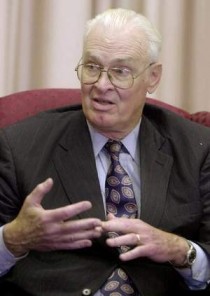
An important process with regards to climate change is the prevalence of naturally occurring multi-decadal periods of fluctuations in both global and local temperature, precipitation, and other climate elements. The usual period of these variations is about 50-70 years or roughly 25-35 years between low to high or high to low periods. The weather 25-35 years ago can often seem different from what we experience today. I have heard many adults say that the weather-climate now is different than when they were a kid. And this is often true. Such multi-decadal periods have always been part of the earth’s climate system. Such changes have been well documented backward in time for thousands of years in paleo-climate data sets of various types. For example, global cooling periods were experienced between 1880-1910, 1945-1975 and the slight global cooling that has been experienced since 1998. Periods of distinct global surface warming occurred between 1910-1940 and 1975-1998.
These changes in climate are hypothesized to be due to the natural back-and-forth swings of the globe’s deep ocean circulation patterns which are primarily driven by upper-ocean salinity differences. These salinity changes are caused by precipitation and evaporation differences on different time and space scales and have no direct association with CO2-induced radiation changes. The Anthropogenic Global Warming (AGW) advocates want us to believe that these natural multi-decadal changes have an important human component that is related to greenhouse gas buildup. This plays well into the hands of those not knowing the causes of such multi-decadal natural climate change.
Surface temperature measurements over the last 130 years have also indicated a weaker and longer multi-century period of upward mean global warming trend upon which the shorter and stronger up-and-down multi-decadal warming and cooling periods are superimposed. This longer and weaker multi-century global warming since the 19th century is also hypothesized to result from the multi-century slow-down of the global ocean’s Meridional Overturning Circulation (MOC) of which the Atlantic Ocean Thermohaline Circulation (THC) plays a major part along with the deep water subsidence surrounding the Antarctic continent. Both of these deep water formation areas are brought about by salinity variations (Figure 1). This long-period global surface temperature rise is also hypothesized to result from the globe’s climate slowly recovering from the Little Ice-Age period when the MOC was in a stronger mode.
The build-up of CO2 in the atmosphere since the start of the industrial revolution (150 years ago) has resulted in (if all other factors are held constant) a very small gradual build-up in the blockage of long-wave infrared radiation (IR) energy flux to space. Up to now this increasing CO2-induced IR blockage accounts for only about 0.6% (1.4 Wm-2 / 235 Wm-2) of the net balancing in-and-out radiation which our planet continuously receives in solar energy gain and simultaneously gives up as IR radiation energy loss to space. This CO2 influence is too small to be isolated in comparison with all of the other much larger global atmosphere-ocean energy changes involving clouds, rainfall, surface-atmosphere exchange, etc. Whatever the increasing CO2 influence is on our climate, it is very small and resides buried in our global climate’s fluctuating noise levels. It will be many decades before this very weak CO2 warming influence can ever be explicitly determined.
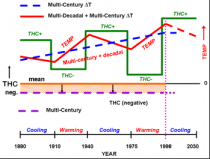
Figure 1. (enlarged) Idealized portrayal of the weaker long-term multi-century temperature increase of 0.6-0.7C that the globe has experienced since the later part of the 19th century (blue dashed line). This is hypothesized to be due to the long multi-century ocean Meridional Overturning Circulation (MOC) slow-down from its earlier period stronger state during the Little Ice Age. Superimposed on this recent long period multi-century ocean circulation warming of are shorter periods of stronger multi-decadal warming and cooling shown by the up-and-down red line. These changes are hypothesized to be driven by the shorter period multi-decadal variations in the salinity-induced strength of the Atlantic Ocean THC (green line). When the Atlantic THC is weak, the globe undergoes weak multi-decadal warming periods of 25-35 years. When the THC is strong the globe typically experiences weak multi-decadal cooling periods of this same approximate length.
The GCMs which say that CO2’s doubling (near the end of this century) will bring about a global warming of as much as 2-5C are badly flawed. All the GCMs have arbitrary and unrealistically incorporated large additional positive water vapor-enhanced warming into their simulations. These extra vapor warming inclusions are directly tied to CO2 increases. They are not at all realistic. My estimate of global warming for a doubling of CO2 is only about 10-15 percent ( around 0.4C) as much as the amount of warming that the global modelers’ project in their IPCC-AR4 report of about 3C.
The severe weather events we have observed over the last two years and this summer’s strong hot and dry conditions over parts of the US are well within the globe’s natural climate variability. Such hot and dry conditions were more extreme in the 1930s. There are many places on the globe right now that are experiencing cooler-than-normal temperatures and above-average precipitation.
We should not let the global warming alarmists, who know little about how the globe’s climate really functions, brainwash us into thinking that humans have had a significant influence on the recent unusual weather-climate events the US has been experiencing. Unusual weather-climate events have always occurred and will always continue to occur, irrespective of the amounts of CO2 we put into the atmosphere.
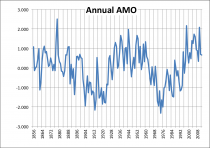
William M. Gray is professor emeritus at the Department of Atmospheric Science at Colorado State University.
From NASA: Research Links Extreme Summer Heat Events to Global Warming
A new statistical analysis by NASA scientists has found that Earth’s land areas have become much more likely to experience an extreme summer heat wave than they were in the middle of the 20th century. The research was published today in the journal Proceedings of the National Academy of Sciences.
Earth’s Northern Hemisphere over the past 30 years has seen more “hot” (orange), “very hot” (red) and “extremely hot” (brown) summers, compared to a base period defined in this study from 1951 to 1980. This visualization shows how the area experiencing ‘extremely hot’ summers grows from nearly nonexistent during the base period to cover 12 percent of land in the Northern Hemisphere by 2011. Watch for the 2010 heat waves in Texas, Oklahoma and Mexico, or the 2011 heat waves the Middle East, Western Asia and Eastern Europe. Credit: NASA/Goddard Space Flight Center Scientific Visualization Studio
Anthony comments on the NASA animation by Dr. James Hansen of surface temperature trends from 1955-1999:
There are many issues with this presentation. It seems to be a big Cherry Picking exercise.
1. Note all of the missing southern hemisphere data. There are operating weather stations during his time, but they are excluded from the analysis. Why?
2. The period chosen, 1955-1999 (in the bell curve animation) leaves out the warmer 1930′s and the cooler 2000′s. Why?
3. The period from 2000-present has no statistically significant warming. Leaving that period out (of the bell curve animation) biases the presentation.
4. The period chosen exhibits significant postwar growth, urbanization is not considered.
5. As for severe weather, Hansen ignores the fact that neither tornadoes nor hurricanes have shown any increase recently. Only smaller tornadoes show an increase, due to reporting bias thanks to easily affordable and accessible technology. NOAA’s SPC reports that July 2012 seems to be at a record low for tornadoes.
6. My latest results in Watts et al 2012 suggest surface station data may be biased warmer over the last 30 years.
The statistics show that the recent bouts of extremely warm summers, including the intense heat wave afflicting the U.S. Midwest this year, very likely are the consequence of global warming, according to lead author James Hansen of NASA’s Goddard Institute for Space Studies (GISS) in New York.
“This summer people are seeing extreme heat and agricultural impacts,” Hansen says. “We’re asserting that this is causally connected to global warming, and in this paper we present the scientific evidence for that.”
Hansen and colleagues analyzed mean summer temperatures since 1951 and showed that the odds have increased in recent decades for what they define as “hot,” “very hot” and “extremely hot” summers.
The researchers detailed how ‘extremely hot’ summers are becoming far more routine. ‘Extremely hot’ is defined as a mean summer temperature experienced by less than one percent of Earth’s land area between 1951 and 1980, the base period for this study. But since 2006, about 10 percent of land area across the Northern Hemisphere has experienced these temperatures each summer.
James Hansen and colleagues use the bell curve to show the growing frequency of extreme summer temperatures in the Northern Hemisphere, compared to the 1951 to 1980 base period. The mean temperature for the base period is centered at the top of the green curve, while hotter than normal temperatures (red) are plotted to theright and colder than normal (blue) to the left. By 1981, the curve begins to shift noticeably to the right, showing how hotter summers are the new normal. The curve also widens, due to more frequent hot events.
Comments from Anthony:
This bell curve proves nothing, as it has the same problems with data as the surface temperature visualization above: cherry picking period, missing data, and contradictory severe weather statistics. This is nothing but a political ploy from a man who has abandoned any pretext of professionally done science in favor of activism. However, in spite of this, it will be used as ‘proof’ by non-thinking individuals like Bill McKibben to promote a political end. Prepare for a barrage of such stories trying to link any observed weather aberration to climate. They’ll use the same level of fact checking like we saw with the melting street lamps last week.
In 1988, Hansen first asserted that global warming would reach a point in the coming decades when the connection to extreme events would become more apparent. While some warming should coincide with a noticeable boost in extreme events, the natural variability in climate and weather can be so large as to disguise the trend.
To distinguish the trend from natural variability, Hansen and colleagues turned to statistics. In this study, the GISS team including Makiko Sato and Reto Ruedy did not focus on the causes of temperature change. Instead the researchers analyzed surface temperature data to establish the growing frequency of extreme heat events in the past 30 years, a period in which the temperature data show an overall warming trend.
NASA climatologists have long collected data on global temperature anomalies, which describe how much warming or cooling regions of the world have experienced when compared with the 1951 to 1980 base period. In this study, the researchers employ a bell curve to illustrate how those anomalies are changing.
A bell curve is a tool frequently used by statisticians and society. School teachers who grade “on the curve” use a bell curve to designate the mean score as a C, the top of the bell. The curve falls off equally to both sides, showing that fewer students receive B and D grades and even fewer receive A and F grades.
Hansen and colleagues found that a bell curve was a good fit to summertime temperature anomalies for the base period of relatively stable climate from 1951 to 1980. Mean temperature is centered at the top of the bell curve. Decreasing in frequency to the left of center are “cold,” “very cold” and “extremely cold” events. Decreasing in frequency to the right of center are “hot,” “very hot” and “extremely hot” events.
Plotting bell curves for the 1980s, 1990s, and 2000s, the team noticed the entire curve shifted to the right, meaning that more hot events are the new normal. The curve also flattened and widened, indicating a wider range of variability. Specifically, an average of 75 percent of land area across Earth experienced summers in the “hot” category during the past decade, compared to only 33 percent during the 1951 to 1980 base period. Widening of the curve also led to the designation of the new category of outlier events labeled “extremely hot,” which were almost nonexistent in the base period.
Hansen says this summer is shaping up to fall into the new extreme category. “Such anomalies were infrequent in the climate prior to the warming of the past 30 years, so statistics let us say with a high degree of confidence that we would not have had such an extreme anomaly this summer in the absence of global warming,” he says.
Other regions around the world also have felt the heat of global warming, according to the study. Global maps of temperature anomalies show that heat waves in Texas, Oklahoma and Mexico in 2011, and in the Middle East, Western Asia and Eastern Europe in 2010 fall into the new “extremely hot” category.
PRESS RELEASE: July 29th, 2012 12PM PDT FOR IMMEDIATE RELEASE
By Anthony Watts
A reanalysis of U.S. surface station temperatures has been performed using the recently WMO-approved Siting Classification System devised by METEO-France’s Michel Leroy. The new siting classification more accurately characterizes the quality of the location in terms of monitoring long-term spatially representative surface temperature trends.
The new analysis demonstrates that reported 1979-2008 U.S. temperature trends are spuriously doubled, with 92% of that over-estimation resulting from erroneous NOAA adjustments of well-sited stations upward. The paper is the first to use the updated siting system which addresses USHCN siting issues and data adjustments.
The new improved assessment, for the years 1979 to 2008, yields a trend of +0.155C per decade from the high quality sites, a +0.248 C per decade trend for poorly sited locations, and a trend of +0.309 C per decade after NOAA adjusts the data. This issue of station siting quality is expected to be an issue with respect to the monitoring of land surface temperature throughout the Global Historical Climate Network and in the BEST network.
Today, a new paper has been released that is the culmination of knowledge gleaned from five years or work by Anthony Watts and the many volunteers and contributors to the SurfaceStations project started in 2007.
This pre-publication draft paper, titled An area and distance weighted analysis of the impacts of station exposure on the U.S. Historical Climatology Network temperatures and temperature trends, is co-authored by Anthony Watts of California, Evan Jones of New York, Stephen McIntyre of Toronto, Canada, and Dr. John R. Christy from the Department of Atmospheric Science, University of Alabama, Huntsville, is to be submitted for publication.
The pre-release of this paper follows the practice embraced by Dr. Richard Muller, of the Berkeley Earth Surface Temperature project in a June 2011 interview with Scientific American’s Michael Lemonick in “Science Talk”, said:
I know that is prior to acceptance, but in the tradition that I grew up in (under Nobel Laureate Luis Alvarez) we always widely distributed “preprints” of papers prior to their publication or even submission. That guaranteed a much wider peer review than we obtained from mere referees.
The USHCN is one of the main metrics used to gauge the temperature changes in the United States. The first wide scale effort to address siting issues, Watts, (2009), a collated photographic survey, showed that approximately 90% of USHCN stations were compromised by encroachment of urbanity in the form of heat sinks and sources, such as concrete, asphalt, air conditioning system heat exchangers, roadways, airport tarmac, and other issues. This finding was backed up by an August 2011 U.S. General Accounting Office investigation and report titled: Climate Monitoring: NOAA Can Improve Management of the U.S. Historical Climatology Network
All three papers examining the station siting issue, using early data gathered by the SurfaceStations project, Menne et al (2010), authored by Dr. Matt Menne of NCDC, Fall et al, 2011, authored by Dr. Souleymane Fall of Tuskeegee University and co-authored by Anthony Watts, and Muller et al 2012, authored by Dr. Richard Muller of the University of California, Berkeley and founder of the Berkeley Earth Surface Temperature Project (BEST) were inconclusive in finding effects on temperature trends used to gauge the temperature change in the United States over the last century.
Lead author of the paper, Anthony Watts, that:
“I fully accept the previous findings of these papers, including that of the Muller et al 2012 paper. These investigators found exactly what would be expected given the siting metadata they had. However, the Leroy 1999 site rating method employed, and employed in the Fall et al 2011 paper I co-authored was incomplete, and didn’t properly quantify the effects.The new rating method employed finds that station siting does indeed have a significant effect on temperature trends”
Watts et al 2012 has employed a new methodology for station siting, pioneered by Michel Leroy of METEOFrance in 2010, in the paper Leroy 2010, and endorsed by the World Meteorological Organization (WMO) Commission for Instruments and Methods of Observation (CIMO-XV, 2010) Fifteenth session, in September 2010 as a WMO-ISO standard, making it suitable for reevaluating previous studies on the issue of station siting.
Previous papers all used a distance only rating system from Leroy 1999, to gauge the impact of heat sinks and sources near thermometers. Leroy 2010 shows that method to be effective for siting new stations, such as was done by NCDC adopting Leroy 1999 methods with their Climate Reference Network (CRN) in 2002 but ineffective at retroactive siting evaluation.
Leroy 2010 adds one simple but effective physical metric; surface area of the heat sinks/sources within the thermometer viewshed to quantify the total heat dissipation effect.
Using the new Leroy 2010 classification system on the older siting metadata used by Fall et al. (2011), Menne et al. (2010), and Muller et al. (2012), yields dramatically different results.
Using Leroy 2010 methods, the Watts et al 2012 paper, which studies several aspects of USHCN siting issues and data adjustments, concludes that:
These factors, combined with station siting issues, have led to a spurious doubling of U.S. mean temperature trends in the 30 year data period covered by the study from 1979 to 2008.
Other findings include, but are not limited to:
· Statistically significant differences between compliant and non-compliant stations exist, as well as urban and rural stations.
· Poorly sited station trends are adjusted sharply upward, and well sited stations are adjusted upward to match the already-adjusted poor stations.
· Well sited rural stations show a warming nearly three times greater after NOAA adjustment is applied.
· Urban sites warm more rapidly than semi-urban sites, which in turn warm more rapidly than rural sites.
· The raw data Tmean trend for well sited stations is 0.15C per decade lower than adjusted Tmean trend for poorly sited stations.
· Airport USHCN stations show a significant differences in trends than other USHCN stations, and due to equipment issues and other problems, may not be representative stations for monitoring climate.
A comparison and summary of trends is shown in Figure 20 from the paper (enlarged):

We will continue to investigate other issues related to bias and adjustments such as TOBs in future studies.
FILES:
This press release in PDF form: Watts_et_al_2012-PRESS RELEASE-R1 (PDF)
The paper in draft form: Watts-et-al_2012_discussion_paper_webrelease (PDF)
The Figures for the paper: Watts et al 2012 Figures and Tables (PDF)
A PowerPoint presentation of findings with many additional figures is available online.
Overview of the paper (PPT)
Methodology – Graphs Presentation (.PPT)
Some additional files may be added as needed.
Contact:
Anthony Watts at: http://wattsupwiththat.com/about-wuwt/contact-2/
References:
GAO-11-800 August 31, 2011, Climate Monitoring: NOAA Can Improve Management of the U.S. Historical Climatology Network Highlights Page (PDF) Full Report (PDF, 47 pages) Accessible Text Recommendations (HTML)
Fall, S., Watts, A., Nielsen‐Gammon, J. Jones, E. Niyogi, D. Christy, J. and Pielke, R.A. Sr., 2011, Analysis of the impacts of station exposure on the U.S. Historical Climatology Network temperatures and temperature trends, Journal of Geophysical Research, 116, D14120, doi:10.1029/2010JD015146, 2011
Leroy, M., 1999: Classification d’un site. Note Technique no. 35. Direction des Systemes d’Observation, Meteo-France, 12 pp.
Leroy, M., 2010: Siting Classification for Surface Observing Stations on Land, Climate, and Upper-air Observations JMA/WMO Workshop on Quality Management in Surface, Tokyo, Japan 27-30 July 2010 PDF
Menne, M. J., C. N. Williams Jr., and M. A. Palecki, 2010: On the reliability of the U.S. surface temperature record, J. Geophys. Res., 115, D11108, doi:10.1029/2009JD013094
Muller, R.A., Curry, J., Groom, D. Jacobsen, R.,Perlmutter, S. Rohde, R. Rosenfeld, A., Wickham, C., Wurtele, J., 2012: Earth Atmospheric Land Surface Temperature and Station Quality in the United States. PDF
Watts, A., 2009: Is the U.S. surface temperature record reliable? Published online.
World Meteorological Organization Commission for Instruments and Methods of Observation, Fifteenth session, (CIMO-XV, 2010) WMO publication Number 1064, available online.
Notes:
1. The SurfaceStations project was a crowd sourcing project started in June 2007, done entirely with citizen volunteers (over 650), created in response to the realization that very little physical site survey metadata exists for the entire United States Historical Climatological Network (USHCN) and Global Historical Climatological Network (GHCN) surface station records worldwide. This realization came about from a discussion of a paper and some new information that occurred on Dr. Roger Pielke Sr. Research Group Weblog. In particular, a thread regarding the paper: Pielke Sr., R.A., C. Davey, D. Niyogi, S. Fall, J. Steinweg-Woods, K. Hubbard, X. Lin, M. Cai, Y.-K. Lim, H. Li, J. Nielsen-Gammon, K. Gallo, R. Hale, R. Mahmood, R.T. McNider, and P. Blanken, 2007: Unresolved issues with the assessment of multi-decadal global land surface temperature trends. J. Geophys. Res.
------------
AMSs reaction to Watt’s paper
By Roger Pielke Sr., Climate Science Blog

source of image: Greenland Summit Station - the plot is of temperatures at the top of the Greenland icecap for the last 30 days.
The current webcam image from this location can be viewed here.
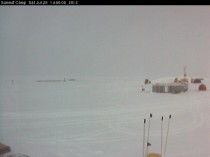
There is a news report by Seth Borenstein titled
NASA: Sudden Massive Melt in Greenland
which reads in part [headline added]
Nearly all of Greenland’s massive ice sheet suddenly started melting a bit this month, a freak event that surprised scientists.
The ice melt area went from 40 percent of the ice sheet to 97 percent in four days, according to NASA. Until now, the most extensive melt seen by satellites in the past three decades was about 55 percent.
Wagner said researchers don’t know how much of Greenland’s ice melted, but it seems to be freezing again.
Summer in Greenland has been freakishly warm so far. That’s because of frequent high pressure systems that have parked over the island, bringing warm clear weather that melts ice and snow, explained University of Georgia climatologist Thomas Mote.
He and others say it’s similar to the high pressure systems that have parked over the American Midwest bringing record-breaking warmth and drought’
The news headline, in particular, is an example of media hype. There was no “massive melt”. The term “massive” implies that the melt involved large masses of the Greenland icecap. They could have written “Sudden Extensive, Short-Term Surface Melting On the Greenland Icecap”, but instead chose to overstate what is a short-term weather event. Melting of surface ice occurs in Greenland whenever there are relatively warm surface air temperatures, as shown in the plot from Summit Station at the top of this post, and sunny skies, as reported by Thomas Mote in Seth’s article. Almost anytime, sublimation (direct transfer from ice to water vapor) occurs.
There has been widespread media reporting of this melting (e.g. Fox News, MSNBC), but the real news story is the overstatement of this weather event by the media (and some scientists at NASA). The headline is the biased part of the article, which Seth may not have much control on, but, regardless, this biased misleading headline needs to be identified.
-------------
By the way, Greenland could from the 1940s to the mid 1990s as CO2 rose. It was only when the Atlantic Multidacadal Oscillation meant warming Atlantic waters, the the warming seen in the early 20th century repeated. It was warmer in the 1940s than currently. Of course to the climate clowns, the world started in 1970.
By Joseph D’Aleo, CCM, Weatherbell Co-Chief Meteorologist
Texas started it all last year, and the palpable pain they felt that was so apparent in the comments received on the Weatherbell site, has spread north like a disease. The Midwest is where the blistering heat has focused this year. The drought is significant and has decimated the corn crop. It is the worst drought since 1988, when corn crop yields fell 30% below trend line yields.
It is driven by the warm pool northwest of Hawaii, the relative warmth NINO12 (+1.1C) versus the NINO34 (+0.5C) (we explain how these two factors are keys on Weatherbell.com) and antecedent conditions.
It was a warm dry zonal winter with the cold trapped in Alaska (still is). The pattern is stuck and persistent. This is the November 2011 to July 22, 2012 anomaly for North America.
The worst droughts for Texas were in 1918, 1956 and 2012, according to Texas State Climatologist Nielsen-Gammon. Those three years 1918, 1956 and 2012 were the strongest La Ninas according to the MEI and SOI. See how this two year bottomed just above 1956’s summer MEI.

Enlarged
In the extended MEI series see 1918 was right there with 1956, 2012. La Ninas mean dry for Texas, super La Ninas super dry. Super dry mean super hot.
You can see the clustering of drought years for Texas in the 1950s and in the 1930s in the graph that follows. For the United States as a whole the 1930s was the worst decade for drought - The Dust Bowl Years. Again here 1918, 1956 and 2012 stand out. The trend is actually up.
Summer heat the last century peaked in 1934, 1980 and 1998 and then 2011 in Texas with no discernable trend since 1895. This is the summer anomalies for Texas through 2011.
The annual trend is 0.00F/decade.
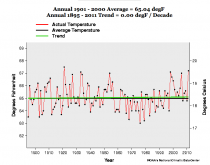
Enlarged
During the 1930s drought, the persistent dryness in the south central built the central heat ridge further and further north eventually setting all time records in many states.

Technically, the driest region of the Plains - southeastern Colorado, southwest Kansas and the panhandles of Oklahoma and Texas - became known as the Dust Bowl, and many dust storms started there. But the entire region, and eventually the entire country, was affected.

Enlarged
The Dust Bowl got its name after Black Sunday, April 14, 1935. More and more dust storms had been blowing up in the years leading up to that day. In 1932, 14 dust storms were recorded on the Plains. In 1933, there were 38 storms. By 1934, it was estimated that 100 million acres of farmland had lost all or most of the topsoil to the winds. By April 1935, there had been weeks of dust storms, but the cloud that appeared on the horizon that Sunday, the 14th, was the worst. Winds were clocked at 60 mph. Day became night.

Enlarged
The day after Black Sunday, an Associated Press reporter used the term “Dust Bowl” for the first time. In the central and northern plains, dust was everywhere. The dust bowl was caused not just by the dry weather but also by unwise farming practices. Earlier settlers plowed under the natural tall grasses that covered the plains and planted crops they had planted in the wetter East. When the drought came, the crops failed, the ground was uncovered and the incessant winds produced the dust storm. After the dust bowl, farmers ended over-cropping, over-grazing and improper farm methods. Since then wheat which is tolerant of drier conditions was grown in the semiarid west and other crops further east.
Dry ground enhances heat. Heat can expand north and east (sometimes even west). This can be clearly seen in the plot of record highs for Des Moines, Iowa for June and July. Note 33 of the records were in the 1930s and interestingly none since 1988 until this year when 2 or 3 were tied or set. With the heat ridge nearby, until it rains, more records could fall. We will update this chart in September when we look back on the summer sizzle. The 1930s will still dominate.
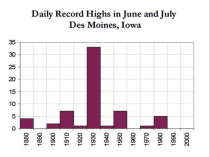
Enlarged
The Iowa first six months of 2012 was the warmest, a touch ahead of 1988 and 1921.
The annual trend is less by a factor of two. We can see the 60 year cycle. We also note, urbanization and land use changes are not adjusted for.
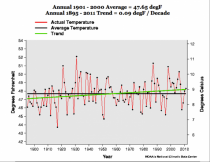
Enlarged
Missouri is ground zero this year and they are similar. First in the January to June averages. the second the annual.

Enlarged
In the annual the 1930s to 1950 dominated with warmth. The positive trend comes from the cold years at the start, the relative secondary max at the end of the record.
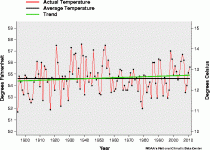
Enlarged
Indeed if you go back 100 years, the trend is 0.00F/decade for annual temperatures in Missouri.
This is true actually for all the states. The 1930s show the most state all-time record highs than any other decade, the 1950s second. The cold records actually peaked in the 1980s and 1960s.
The warmest, droughtiest decades are those with a warm Atlantic (+AMO). The 1930s had a warm Pacific (+PDO) with one important exception 1934. The 1950s like the last three years have had a cold Pacific (- PDO).
The importance of the AMO to drought 9and thus heat) was shown by McCabe (2004):
Drought frequencies are highest (reds) in the AMO states (two right maps). The PDO determines the region. We are bottom right this year.
One last chart...the US is only a small part of the earth’s surface (less than 2%). There has been no warming for over a dozen years.
UPDATE:
COLD SUMMER IN ALASKA
Gloomy summer headed toward infamy CHILLY: Anchorage could hit 65 degrees for fewest days on record.
By GEORGE BRYSON gbryson@adn.com
Published: July 24th, 2008 12:10 AM Last Modified: July 24th, 2008 04:56 PM
The coldest summer ever? You might be looking at it, weather folks say. Right now the so-called summer of ‘08 is on pace to produce the fewest days ever recorded in which the temperature in Anchorage managed to reach 65 degrees. That unhappy record was set in 1970, when we only made it to the 65-degree mark, which many Alaskans consider a nice temperature, 16 days out of 365.This year, however—with the summer more than half over—there have been only seven 65-degree days so far. And that’s with just a month of potential “balmy” days remaining and the forecast looking gloomy.
National Weather Service meteorologist Sam Albanese, a storm warning coordinator for Alaska, says the outlook is for Anchorage to remain cool and cloudy through the rest of July."There’s no real warm feature moving in,” Albanese said. “And that’s just been the pattern we’ve been stuck in for a couple weeks now.
“In the Matanuska Valley on Wednesday snow dusted the Chugach. On the Kenai Peninsula, rain was raising Six-Mile River to flood levels and rafting trips had to be canceled.So if the cold and drizzle are going to continue anyway, why not shoot for a record?
The mark is well within reach, Albanese said: “It’s probably going to go down as the summer with the least number of 65-degree days.
“MEASURING THE MISERY In terms of “coldest summer ever,” however, a better measure might be the number of days Anchorage fails to even reach 60.There too, 2008 is a contender, having so far notched only 35 such days—far below the summer-long average of 88.Unless we get 10 more days of 60-degree or warmer temperatures, we’re going to break the dismal 1971 record of only 46 such days, a possibility too awful to contemplate.
Still, according to a series of charts cobbled together Tuesday evening by a night-shift meteorologist in the weather service’s Anchorage office, the current summer clearly has broken company with the record-setting warmth of recent years. Consider: 70-degree days. So far this summer there have been two. Usually there are 15. Last year there were 21. In 2004 there were 49. 75-degree days. So far this summer there’s been zero. Usually there are four. It may be hard to remember, but last year there were 21. In 2004 there were 23.
---------
By Katie Medred, Alaska Dispatch
In Interior Alaska summer feels like it’s over. Meanwhile, Southcentral Alaska is in the middle of possibly the chilliest July ever, while Southeast has mournfully reported the lowest summer-time temperature recorded in over 65 years.
So how are residents of the icebox handling this “coldest-Alaskan-summer-ever” talk while many in the Lower 48 sizzle in record heat? After all, don’t Alaskans say this every summer?
KTUU reports that some residents are so fed up they’re looking for ways to get out of state in a quest for more sun.
The Fairbanks Daily News-Miner expresses resentment over this summer’s consecutive 60-degree days in Alaska’s second-largest city, which is normally known for 80 and 90s in the summer.
And then there’s Barrow, which as of July 15, has received the tell-tale sign of summer’s end—termination dust.
According to Sarah Nicely, program administrator at the North Slope Borough Mayor’s Office, there had been talk that it might snow around America’s northernmost town, but no one was seriously prepared for the dusting.
“I was leaving the mayor’s office to head on over to a camp and, as I was pulling out, I looked and I thought, ‘What is that?’” she told Alaska Dispatch’s Jill Burke. “I (had thought) it was going to rain, but I realized, ‘Oh my goodness, it’s snow!’”
----------
Joe Bastardi Puts The Heatwave In Perspective
Posted on July 22, 2012
Real Science Guest Post By Joe Bastardi
----------
Any of the Climate Clown Media sheep stop to think about this
The map below shows the Alaska imprinted on the US, in the area where the heat wave is worst, and then the July temps in North America showing that the Alaskan cold is at least holding its own, and arguably outdueling the US warmth. This is much like the pattern in the 1950s.
The question is will the Media swallow and follow sheep ever wake up and do a lick of digging into this, or keep marching along like drones to a drumbeat of mindless drivel. How not one of the mainstream climate writers that buy into AGW don’t stop and look at the loads of information that should make them question this shows mindless blindness.
Heh I like that mindless blindness. Has a nice ring to it
by E. Calvin Beisner, Master Resource, July 18, 2012
“When I attended the United Nations climate summit in Copenhagen in 2009, the most common sign I saw carried by the 40,000-plus protesters in the streets (of whom the two largest groups were the International Socialist Youth Movement and the Community Party) said, ‘System change, not climate change’ - -i.e., give us global socialism, not global free markets!”
If you believe global warming is cyclical and mostly natural; human contribution is minor and not dangerous; and attempting to prevent human influence by cuts in carbon-dioxide emissions would cost trillions of dollars, trap billions of people in developing countries in poverty, and so do more harm than good, then you must be armed and prepared to act in our political times.
President Barack Obama, indeed, has warned us by saying that “he most important policy he could address in his second term is climate change.”
The Challenge Before Us
“Climate change” - what proponents called “global warming” before the globe stopped warming 17 years ago - has become the mother of all excuses for spending trillions of dollars, killing millions of jobs, trapping billions of people in poor countries in poverty, expanding government’s control over our lives, and creating distant, unaccountable, global government.
As University of East Anglia Professor of Climate Change and Marxist/socialist Mike Hulme, a vigorous proponent of “post-normal science,” put it in his book, Why We Disagree about Climate Change:
The function of climate change I suggest, is not as a lower-case environmental phenomenon to be solved...It really is not about stopping climate chaos. Instead, we need to see how we can use the idea of climate change- the matrix of ecological functions, power relationships, cultural discourses and materials flows that climate change reveals - to rethink how we take forward our political, social, economic and personal projects over the decades to come.
Climate change has become an idea that now travels well beyond its origins in the natural sciences...climate change takes on new meanings and serves new purposes...climate change has become “the mother of all issues”, the key narrative within which all environmental politics - from global to local - is now framed… Rather than asking “how do we solve climate change?” we need to turn the question around and ask: “how does the idea of climate change alter the way we arrive at and achieve our personal aspirations...?”
Little wonder that when I attended the United Nations climate summit in Copenhagen in 2009, the most common sign I saw carried by the 40,000-plus protesters in the streets (of whom the two largest groups were the International Socialist Youth Movement and the Community Party) said, “System change, not climate change” - i.e., give us global socialism, not global free markets!
Having failed to get cap-and-trade through Congress, Obama, true to his observation that “there’s more than one way to skin a cat,” had his Environmental Protection Agency act to impose Draconian measures on us by first “finding” that CO2 - a natural compound essential life, expelled with every breath - is a “dangerous pollutant” because it causes global warming, and then imposing restrictions on its emissions, first from vehicles, then from stationary sources like electric power plants.
Though not ruling on the scientific merits of EPA’s climate alarmism, the nation’s courts have so far rejected legal challenges to EPA’s actions. So the result, if such policies are not reversed by Congress, will be trillions of dollars in lost economic production and millions of lost jobs in the next two decades, and, much sooner, the skyrocketing electricity prices Obama promised during his campaign, and consequently rising prices for everything produced and transported using electricity - which is just about everything.
Challenging Church Environmental Hype/Alarmism
Last month, a three-part series, “Evangelicals and Climate Change” (June 12, June 20, and June 27), explained the role of the Cornwall Alliance as the leading voice for evangelicals who reject climate alarmism and strive to protect the world’s poor from harmful, and futile, efforts to fight global warming.
The Christian Post cited our Evangelical Declaration on Global Warming, endorsed by hundreds of evangelical scientists, economists, theologians, and other leaders and based on our landmark study, A Renewed Call to Truth, Prudence, and Protection of the Poor: An Evangelical Examination of the Theology, Science, and Economics of Global Warming, as representing not only Cornwall’s thought but also that of many other evangelicals, including the Southern Baptist Convention, America’s largest evangelical denomination.
The Other Side
But we face an uphill battle in the religious community. Climate alarmism has powerful, well-funded voices seeking to influence the evangelical community. Consider what we are trying to counter:
· The Evangelical Climate Initiative, launched with a $475,000 grant from population control-advocating Hewlett Foundation, continues to present its alarmist view as the dominant evangelical position - despite the Cornwall Alliance’s having refuted its science and economics point-by-point in A Call to Truth, Prudence, and Protection of the Poor: An Evangelical Response to Global Warming.
· The Evangelical Environmental Network, heavily funded by the population control-advocating Rockefeller Brothers Fund, has equated support for CO2 emission restrictions with being “pro-life,” obscuring the meaning of “pro-life,” threatening to divide the pro-life vote, and risking leaving Congress in control of pro-abortion forces for decades to come - despite the Cornwall Alliance’s having produced Protecting the Unborn and the Pro-Life Movement from a Misleading Environmentalist Tactic: A Joint Statement by Pro-Life Leaders, repudiating EEN’s similar claim with regard to mercury emissions.
· Former National Association of Evangelicals Vice President for Government Affairs Richard Cizik, with major financial assistance from billionaire Left-wing media mogul and population-control advocate Ted Turner’s United Nations Foundation and billionaire Left-wing globalist George Soros continues to promote government family planning programs as both “godly and green” ways to fight global warming.
· Socialist Jim Wallis’s Sojourners, also with heavy funding from Soros, this year hired a director of climate change campaigns to enlarge its influence.
The Cornwall Alliance, like many other sound-science and sound-economics groups, has much work to do to counter-climate alarmism and other environmental hype. Understanding not just the science, economics, and politics of the climate-change battle but also underlying worldview and ethical issues is crucial to winning this fight and keeping churches from having their message and mission compromised by a movement that undermines their foundational beliefs.
- - - -
E. Calvin Beisner, Ph.D., is Founder and National Spokesman of The Cornwall Alliance for the Stewardship of Creation. A coalition of theologians, pastors, ministry leaders, scientists, economists, policy experts, and committed laymen, the Cornwall Alliance is the world’s leading evangelical voice promoting environmental stewardship and economic development built on Biblical principles.
By Lucia, the Blackboard
Update: I said if I found temperature for the lower 48 I’d run them. I did and it totally revised my conclusions. It seems white noise isn’t such a bad assumption for temperatures in the lower 48, and the probability of the recent event really is quite low. I revised at the end!
-----
At wunderground.com Jeff Masters writes
U.S. heat over the past 13 months: a one in 1.6 million event
I call BS on that claim.
He goes on:
Each of the 13 months from June 2011 through June 2012 ranked among the warmest third of their historical distribution for the first time in the 1895 - present record. According to NCDC, the odds of this occurring randomly during any particular month are 1 in 1,594,323. Thus, we should only see one more 13-month period so warm between now and 124,652 AD–assuming the climate is staying the same as it did during the past 118 years. These are ridiculously long odds, and it is highly unlikely that the extremity of the heat during the past 13 months could have occurred without a warming climate.
What this really is is a meaningless statistics.
Let’s look at how it is computed.
Someone assume we have an unfair coin and the probability of getting heads is 1/3rd. What are the chances of getting 13 heads in a row? The answer is 1 in 313 = 1 in 1,594,323.
Okey. Dokey.
Here’s the problem: That calculation only applies to cases where the results for each coin flip are statistically independent or at least uncorrelated. This would make sense if we believed that month-to-month variations in temperature anomalies could be described by something called “white noise”.
But this is not true for monthly temperature and would not be even absent climate change. We know that month-to-month variations in temperature are correlated. This is so well understood that NOAA has names for large persistent weather patterns. Names like “El Nino/La Nina” (i.e. ENSO). Other persistent weather patterns exist.
In fact - the entire reason weather forecasting is possible at all is that we know weather patterns persist. Master’s calculation is based on the assumption weather patterns do not persist!.
Let’s tweak Dr. Master’s rather imperfect calculation by retaining his assumption that “climate is staying the same as it did during the past 118 years” but accounting for “persistence”. More specifically we will assume that there is non-zero serial auto-correlation in the monthly data. Since he used “white” noise, I’m going to pick the next simplest model: Red noise (i.e. AR1 noise.)
Master’s used continental US data. Because I have easy access to NOAA’s global data and have already coded a script to read it, I’ll use global data instead of data for the lower 48. (If someone gets me data for the continental US, I’ll repeat in an update.)
I start by downloading data from Jan. 1895 to Jun. 2012 from NOAA here.
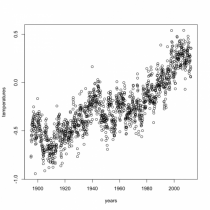
I fit a model that assumed the temperature exihibits no systematic trend and with monthly variability modeled by “red” noise, (instead of Master’s choice of “white"). Doing so I estimate a lag 1 coefficient of R=0.936.
Next, I create a series of 1409 ‘months’ worth of data synthetic “weather” that is nothing more than “red noise”. I inspect the final 13 months to see if the minimum value is in the top 1/3rd of temperature based on the temperature record - but excluding the final 13 months themselves. If all thirteen months are in the top 1/3rd, the outcome for this case is 1. Otherwise, it’s 0.
Then, confident that it will not take 1,594,323 tries to end the string with a record, I repeated this computation 10^4 times. This results in a string of 10,000, 0s and 1s. Taking the mean of the series, I found that “assuming the climate is staying the same as it did during the past 118 years” the probability of 10% plus/minus 0.4% the final 13 months would fall in the top 1/3rd of historic temperatures observations.
Note that 1 in 10 times is much more likely than 1 in 1,594,323.
And my calculation is for the entire surface of the earth. I’m not cherry picking by finding the one country that happens to be having a sustained heat wave while other parts of the world are not experiencing the same heat wave.
So, what does the 10% probability this mean about global warming?
Nothing. Absolutely nothing. What this means is that trying to demonstrate global warming by estimating the odds of getting 13 months of temperatures in the top 1/3rd of historic records under the assumption that the climate has not changed is often a stoooopid way of proving or disproving global warming.
Heaven knows, as a method to analyze the temperature data the method I used has flaws– all I did was remove one of the obvious flaws in Jeff Masters’s method. But with one less flaw than his method, my estimate of 10% probability this would happen is certainly no worse than the estimate Jeff Masters posted at WunderBlog.
For those wondering if I have a swag of how likely this event would be if climate change had not happened: it’s 1.4%. That’s just a swag based on detrending and then computing R. But, using that value, assuming a lifetime of approximately 70 years, one would expect to see this sort of excursion heat wave happen even without climate change. As it happens, I think the planet has warmed. But someone is going to have to do a lot better than Jeff Master’s to turn this heat wave by itself into proof the climate has warmed.
Update: I googled to read who’d blogged. Michael Tobis commented:
Actually that’s bad form from both Masters and NCDC.1.6 million (more precisely, 1,594,323) to one is just the thirteenth power of 1/3, which overstates the case to the extent that successive monthly anomalies are correlated. (Also the 1/3 is somewhat arbitrary and could be a cherry pick, but leave that aside). I don’t doubt that something very odd is going on but the number represents a common elementary statistical error and is in this case excessively alarmist.
Is this the first time MT and I have agreed on something? ![]()
Update Wow! I didn’t realize the US temperatures had such low serial auto-correlation! I obtained data for the lower 48 states here.
Based on this, the lag 1 autocorrelation is R=.150, which is much lower than R=0.936. So ‘white noise’ isn’t such a bad model. I am getting a probability less than 1 in 100,000. I have to run the script longer to get the correct value!
By Joseph D’Aleo, Weatherbell.com
We are heading back to the 1950s in our climate and weather. With a positive AMO (last month +0.90 STD) and a negative PDO (last month -1.26 STD), we are most like the early to middle 1950s and late 1950s to early 1960s. Notice how we were in this mode after the super El Nino of 1998 for several years before the strong El Nino fo 2002/03 and the strong second solar max reverted us back to a positive PDO. After 2007, the PDO has settled into the cold Pacific and warm Atlantic mode.
Some believe the warm Atlantic mode actually began in the late 1980s which may have helped Hugo in 1989 before Pinatubo and Cerro Hudson in 1991 like El Chichon in 1982 may have cooled the Atlantic like it cooled the globe. The Atlantic returned warm in 1995. Dr Bill Gray has shown the warm AMO favors more Atlantic Basin storms and increased landfalls. East coast landfalls are more likely when the Pacific is cold (Irene last year). Weatherbell’s Joe Bastardi predicted overall activity would be down this year though above the normal with slightly cooler tropics and El Nino but that storms would tend to develop close to the mainland (as 3 of the first 4 did). We also believe the east coast is again vulnerable as it was in the 1950s.
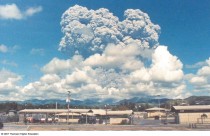
El Chichon 1982 above and Pinatubo 1991 below

Note how much blockage of solar radiation occurred at Mauna Loa from these major eruptions. That cooled the land and the oceans (most notably the Atlantic). The volcano enhanced El Ninos (weakened Hadley circulation and weakened easterlies allowing warm water from the western tropical Pacific to come east) kept the PDO positive.
You can see how the La Ninas are favored in the cold modes and El Ninos in the warm mode. This is annual NINO34. We usually see ENSO peak in the October to February time frame. See how after the 2002 El Nino and second solar max, the PDO popped positive then gradually faded in the first graph above and how NINO34 behavior followed suit.
Is there evidence for the 60 year cycle elsewhere in climate and nature? Most defintely as nicely shown in more detail here by Alan Cheetham.
(1) AMO (approximately 62 years) as seen in the first graph
(2) PDO (approximately 60 years) as seen in the first graph
(3) Global temperatures (60 years)
See how the warming from 1888 to 1940 parallelled the 1950 to 2000 warming
The following figure is from a study by Basil Copeland and Anthony Watts, showing a Morelet wavelet analysis of the HadCRUT3 global temperature anomalies [link] The ~62-year cycle is clearly visible.
(4) Southwest drought (64 years)
We are heading to a phase where southwest drought is more likely (consistent with a warm AMO and cold PDO with more and stronger La Ninas).
(5) Atmospheric Circulation Index (zonal versus merdional) (60 years)
We were more zonal than normal a decade or so ago and this helped make AO+ and produce less extremes by producing more variability. Now we are heading down into very meridional territory like the 1950s and 1960s and 1970s when extremes were common, when major troughs and ridges dominated and tended to persist produce great extremes.
(6) ENSO state frequency (60 years)
Here as shown we are back in a La Nina favored mode due to -PDO. We get more frequent, often multi-year La Ninas and briefer El Ninos.
(7) Thermohaline circulation (60 years)
We are in a strong phase favoring +AMO.
(8) ITCZ strength and location (60 years)
(9) Length of Day (LOD) which may influence climate and FAO reports correlates well with fish catches. Ties well with ACI in 5 above
What is behind a 60 cycle? You probably would not be surprised it is the sun/solar system.
Nicola Scafetta has identified the change in the location of the center of mass of the solar system (CMSS) as a possible mechanism driving the 60-year cycle. (Scafetta, N., “Empirical evidence for a celestial origin of the climate oscillations and its implications”, Journal of Atmospheric and Solar’Terrestrial Physics (2010)
Scafetta shows the following figures described as: ([A- (top)) Rescaled SCMSS 60 year cycle (black curve) against the global surface temperature record (grey) detrended of its quadratic fit; (B- (botttom)) Eight year moving average of the global temperature detrended of its quadratic fit and plotted against itself shifted by 61.5 years. Note the perfect correspondence between the 1880-1940 and 1940-2000 periods. Also a smaller cycle, whose peaks are indicated by the letter “Y”, is clearly visible in the two records. This smaller cycle is mostly related to the 30-year modulation of the temperature. These results reveal the natural origin of a large 60-year modulation in the temperature records.” (SCMSS – Speed of the CMSS)
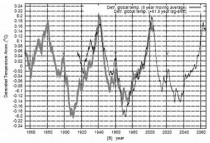
Enlarged
So in summary what can we expect for the next say 10 years?
(1)Temperatures globally which stopped rising in 1997 will begin accelerating down
(2) More meridional patterns and reduced variability which translate into more extremes - warm and cold, floods and droughts
(3) More southwest, southern and central drought and global droughts and floods
(4) More La Ninas - stronger and longer lasting. Briefer, weaker El Ninos
(5) More hurricanes and landfalls in the Atlantic
(6) More La Nina impacts including hurricanes, tornadoes, floods, winter snows north (south and east in the occasional El Ninos)
All of this will of course be attributed to CO2 even though CO2 doesn’t correlate with the changes shown and is a beneficial gas that increases crop yields .
This year yields will drop dramatically for the third straight year, this yyear with tens of billions of dollars in crop losses likely. In 1988, the last major drought, losses were over $80B (2008S). Yields can be reduced by droughts and as in 1993 by massive floods). This ties into the ACI above. When the patterns are very meridional they are subject to persistence and extremes. That was the reason for the 1910s, 1930s and 1950s droughts. and the 1988 drought. See much more on similarities to 1988 and 1911 in posts on Weatherbell.com this week.
US climate annual temperature have fallen in 67 years and risen in only 44 years since 1895 while CO2 has risen, not a very convincing driver.
We are told, natural variability has been ruled out. It seems to me they never seriously looked. These are the same folks (including Mann and Schmidt) who this week admitted they didn’t the difference between a derecho and the Geico gecko.





